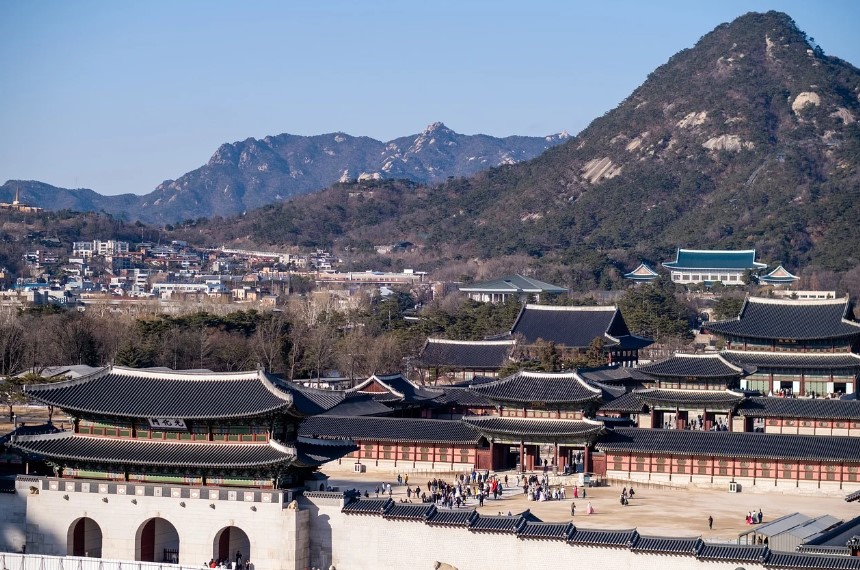Discover the Beauty and History of Gyeongbokgung Palace
If you’re planning a trip to Seoul, Gyeongbokgung Palace is an absolute must-visit. This stunning palace, located in the heart of the city, offers a deep dive into Korea’s rich royal history, breathtaking architecture, and traditional culture. Let’s explore why Gyeongbokgung should be at the top of your travel list.

A Brief History
Gyeongbokgung, meaning “Palace Greatly Blessed by Heaven,” was built in 1395 during the Joseon Dynasty. As the largest of the Five Grand Palaces in Seoul, it served as the primary royal residence for over 500 years. Although much of the palace was destroyed during the Japanese invasions in the 16th century and again during the Japanese occupation in the early 20th century, it has been painstakingly restored to its former glory.
Today, Gyeongbokgung stands as a symbol of Korea’s resilience and pride, offering visitors a glimpse into the grandeur of the Joseon Dynasty.
Key Features and Highlights
1. Geunjeongjeon Hall (Throne Hall):
This is the main throne hall where kings conducted official affairs. The hall’s grand scale and intricate details make it one of the most impressive parts of the palace. Don’t forget to look up and admire the beautiful wooden ceiling, painted in vibrant colors.
2. Gyeonghoeru Pavilion:
This picturesque pavilion, located on an artificial island in a large pond, was used by the royal family for banquets and entertainment. It’s one of the most photographed spots in the palace, offering a serene view of the water and surrounding mountains.
3. Hyangwonjeong Pavilion:
Another stunning pavilion built on a small, secluded pond, Hyangwonjeong offers a peaceful retreat. The wooden bridge leading to the pavilion makes for a perfect photo opportunity, especially during autumn when the foliage turns vivid shades of red and gold.
4. The Changing of the Royal Guard Ceremony:
One of the highlights of visiting Gyeongbokgung is witnessing the Royal Guard Changing Ceremony at the main gate (Gwanghwamun). The ceremony, which takes place multiple times a day, features traditionally dressed guards and is a great way to experience Korea’s royal customs.
Why Visit Gyeongbokgung?
1. A Window Into Korean History:
Gyeongbokgung is not just a palace; it’s a living museum. Walking through its vast courtyards and majestic halls, you’ll gain a deeper understanding of Korea’s past, from royal life to political affairs. The National Palace Museum of Korea, located within the palace grounds, also offers fascinating exhibits on the Joseon Dynasty.
2. Breathtaking Architecture:
The palace is a masterpiece of traditional Korean architecture. The balance of nature and human craftsmanship is evident in the way the buildings harmonize with the surrounding landscape. Each structure tells a story, from the delicate tile roofs to the colorful, intricate patterns that decorate the eaves.
3. Cultural Immersion:
Visiting Gyeongbokgung is a great way to experience Korean culture firsthand. Many tourists and locals wear hanbok (traditional Korean clothing) when visiting, which adds to the authentic feel of the experience. Plus, wearing hanbok gives you free entry to the palace!
4. Perfect Location:
Gyeongbokgung is situated in central Seoul, making it easy to visit other nearby attractions. You can explore Bukchon Hanok Village, a traditional Korean village, or take a stroll down Insadong, a street known for its art galleries, traditional tea houses, and souvenir shops.
Practical Information
- Location:
Gyeongbokgung Palace is located at 161 Sajik-ro, Jongno-gu, Seoul, South Korea. The nearest subway station is Gyeongbokgung Station (Line 3, Exit 5) or Gwanghwamun Station (Line 5, Exit 2). - Opening Hours:
The palace is open from 9:00 AM to 5:00 PM (hours may vary seasonally). The last admission is one hour before closing. - Admission Fees:
Standard entry costs 3,000 KRW (approximately 3 USD). Wearing hanbok will grant you free access. - Best Time to Visit:
Gyeongbokgung is beautiful year-round, but visiting in the spring or autumn offers the most spectacular views due to cherry blossoms and autumn foliage.
Final Thoughts
A visit to Gyeongbokgung Palace is like stepping back in time. Whether you’re a history buff, a photography enthusiast, or simply someone looking to explore the cultural heart of Seoul, this palace offers something for everyone. From its majestic structures to its tranquil gardens, Gyeongbokgung is a testament to Korea’s rich heritage and should not be missed.
Make sure to add this historical gem to your itinerary for an unforgettable journey into Korea’s royal past!
